OK, so I’m 3 days late. That’s about par for me. Besides, good things take longer! Lots of stuff to talk about.
INES Level 7
It took awhile but politics are now entering the picture. I refer to the very unfortunate uprating of the Fukushima incident to Level 7, the same level as Chernobyl. This has, of course, given the media a field day. If I see “on par with Chernobyl” one more time I think I’ll puke!
This incident is not on par with Chernobyl. It’s not even the same order of magnitude. The problem is the IAEA’s INES scale which is child-like in its simplistic approach to rating incidents and accidents. You can read the guide here [1] if you must. It depends almost entirely on how much “inconvenience” is caused off-site. That, in turn, depends on sometimes very unwise decisions regarding evacuations and other restrictions. In other words, it is not science based but politically based.
Here are some facts as published by TEPCO, the utility. They calculated that there were about 500 million curies in the cores of the reactors. This is easily calculated from the core burn-ups. The utility then guesses that about 10% of that amount or about 50 million curies were released. This is just a guess since there was no way to measure the release, especially with no source of power to the instrumentation.
I think that this estimate is high. They are probably basing that on NUREG-1465 which models source terms for various kinds of accident scenarios. The NRC notes in the footnotes that the values listed in the source term tables are estimates that are conservative (tend to over-estimate the releases) which is proper for evaluating a plant’s containment system. It is not proper to use this to estimate releases from an actual event.
I’m basing my estimation on the reported dose rates and air concentrations around the plant. There just isn’t enough dose to account for that high a level of activity.
Chernobyl Comparison
The media and several commentators have jumped on the INES rating to equate this incident with the accident at Chernobyl. The two are vastly different. The parameter that matters most is the amount and type of released activity. Chernobyl released over 10 times as much radioactivity if the estimates of the two are to be believed. Worse, much of Chernobyl’s release was Cs-137 which, with a half-life of about 30 years, remains to contaminate the ground today. The bulk of Fukushima’s release has been I-131 which decays with an 8 day half-life. Thus, even of the estimates are correct, the amount of I-131 in the environment halves every 8 days and so is not a long term problem.
Here is another comparison between the two incidents, this time from Reuters [2].
The Unfortunate Evacuations
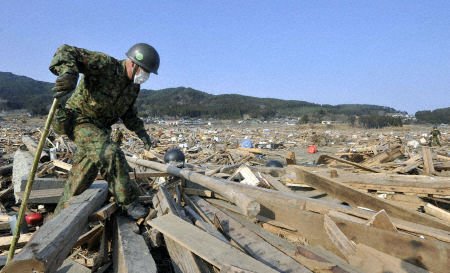 In my opinion, the evacuations beyond the initial 10km precautionary one are uncalled-for. The initial evacuation was appropriate for two reasons. One, it gave the plant personnel some breathing room when they knew they were going to have to vent the reactor vessels to the atmosphere to relieve the reactor and containment pressures. They didn’t have to worry about nuking people close in. Second, as the photo to the left shows (from the Kyodo News Service), the area inside the 10km radius is a wreck. Hard to imagine that kind of damage.
In my opinion, the evacuations beyond the initial 10km precautionary one are uncalled-for. The initial evacuation was appropriate for two reasons. One, it gave the plant personnel some breathing room when they knew they were going to have to vent the reactor vessels to the atmosphere to relieve the reactor and containment pressures. They didn’t have to worry about nuking people close in. Second, as the photo to the left shows (from the Kyodo News Service), the area inside the 10km radius is a wreck. Hard to imagine that kind of damage.
The other evacuations have been based on less tangible reasons. As with much information about this accident, various sources conflict with each other but as best I can discern, the evacuation orders are being based on the possibility of a member of the public receiving 2 REM or more per year. This is inappropriately low. Remember that under normal conditions a civilian can receive 1 REM/yr and a radiation worker can receive 5 REM (upped to 25 REM for this incident). Thus this evacuation is based on a person receiving only twice as much radiation as the already absurdly low limit permits. And this assumes that the radiation levels remain the same.
They won’t. The predominant I-131 will rapidly decay away as previously discussed. The other isotope of concern, Cs-137, will be washed away and diluted by rain until only a small residue remains.
For any protective measure one must weigh the cost vs benefit. In this case the cost is immense, both in monetary terms and emotionally. People are kept away from their homes. They’re prevented from starting recovery. All work has stopped in the evacuation zone, leading to economic hardship for the businesses involved. All that to avoid a paltry extra REM. I hope that their political leaders quit responding to the media and use some common sense.
That Tsunami
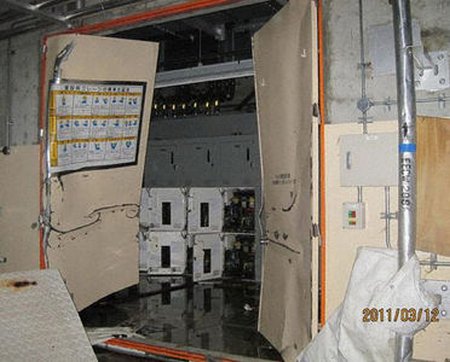 Today I found this article [3] where they’ve determined the height of the tsunami. Roughly 125 feet if I did the units conversion correctly. Can you imagine that? A wave the size of a 12 story building bearing down upon you. No wonder the area is so devastated. It’s amazing that Fukushima fared as well as it did.
Today I found this article [3] where they’ve determined the height of the tsunami. Roughly 125 feet if I did the units conversion correctly. Can you imagine that? A wave the size of a 12 story building bearing down upon you. No wonder the area is so devastated. It’s amazing that Fukushima fared as well as it did.
The photo at left (from TECO) shows some of the damage. The high security doors were battered open. Then the motor control centers (MCCs) in the room were flooded. These MCC will not be dried out and the salt contamination removed any time soon, assuming they’re not physically wrecked. These panels control various motors and pumps in the plant. If a significant portion of the plant looks like this then normal cooling via closed circulation won’t be coming back anytime soon.
The Fire
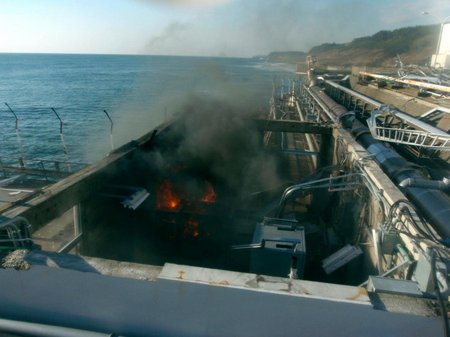 [4]Much ado has been made about the fire that happened a couple of days ago at the plant. As usual a media mountain was fabricated out of a mole hill.
[4]Much ado has been made about the fire that happened a couple of days ago at the plant. As usual a media mountain was fabricated out of a mole hill.
The photo at left (TEPCO via cryptome.com) shows what actually happened. This is a seawater sampling station that had a large battery backup system (UPS). Probably from seawater contamination, the batteries caught fire. The fire was quickly extinguished and did no significant damage. The whole thing was unrelated to nuclear safety.
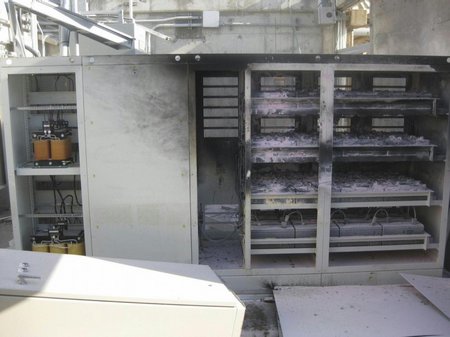 [5]This photo shows just how small the burned area is. Just a battery box.
[5]This photo shows just how small the burned area is. Just a battery box.
Unit 4 Spent Fuel Pit Condition
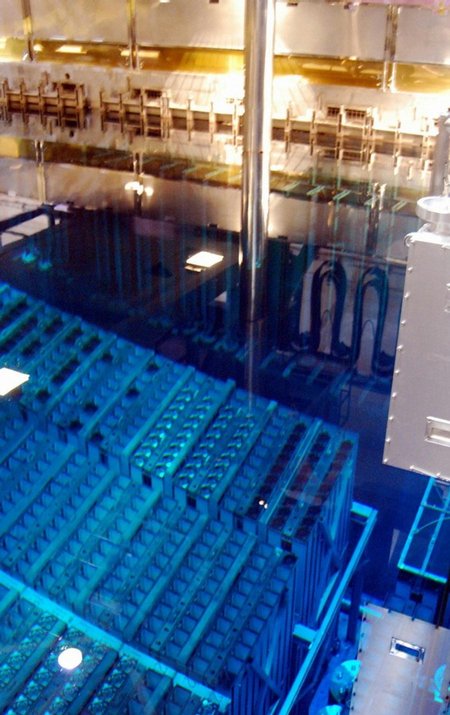 [6]The status of the large Unit 4 spent fuel pit has been of some significant concern. Yesterday they used one of the concrete pumper boom trucks to take a water sample from the pit, along with temperature readings.
[6]The status of the large Unit 4 spent fuel pit has been of some significant concern. Yesterday they used one of the concrete pumper boom trucks to take a water sample from the pit, along with temperature readings.
The raw data is thus:
Cs-134      88
Cs-137    93
I-131      220 Bq/cc
This is a significant concentration of isotopes but not unexpected, considering that the pit boiled dry during the power outage. This shows that there is some amount of damaged fuel in the pit. The water is normally kept so pure that the activity level is below the limit of detection.
The radiation reading at the surface of the water was about 10R/hr. That is also significant but again, not unexpected. The report is that the water level is only about a third of its normal depth. The water normally cools and shields the fuel.
The water temperature was reported to be about 90 deg C and boiling is probably going on in some areas where the fuel is the newest. Yet again, not unexpected since the spent fuel pit cooling system is not working. There is no radiological consequence of the water boiling. Just another way of carrying away the heat.
The photo illustrates what is known as high density storage. Most of the cells in the photo are empty. Fuel bundles are at the bottom left of the photo and at the top. The space between each cell is filled with a neutron absorbing material that is designed to preclude any possibility of criticality even though the bundles are tightly packed together.
Reactor Status
From the data released by the IAEA [7], all three reactors are at least partially dry. Likely Units 2 and 3 are totally dry. For Unit 1, they’ve been able to access a feedwater line which leads to the reactor’s internals. How much water is getting in and how much is being displaced by gas is unknown. From the temperature readings on the vessel, I’m guessing that not much is getting in. Units 2 and 3 are being cooled by water injected through the fire protection line which I think discharge on the outside of the reactor vessel (Memory’s bad on the fire protection sparger location and I can’t find my GE systems manual to be sure.)
That the reactors are (mostly, at least) dry and in equilibrium states just illustrates the absurdity of the China Syndrome fallacy. The fuel in all three reactors melted but even without the restoration of cooling water flow, as happened at TMI, the cores did not melt through the reactor vessels as some predicted.
Worst Case Scenario
Yer lookin’ at it, bub! All the caterwauling from people inside and outside various governments aside, this is, in my opinion the worst event that could happen to a US-designed reactor. Severe earthquake damage followed by a long term total loss of power and reactor cooling, followed by massive hydrogen explosions. Hard to imagine anything worse. Yet the radiological consequences to anyone off-site are nil. Even on-site, the highest exposure that I’ve been able to find out about is about 20 REM, still below the accident guidelines.
All kinds of Lessons Learned are going to come out of this by the “generals fighting the last war” but what should come out of the incident is that even first generation reactors are inherently safe enough to protect the population around them. More modern reactors are even safer and the new generation of reactors now being planned are even safer than that. A pretty good performance in my book.